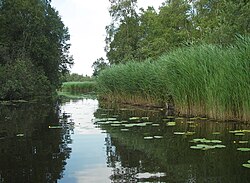Vechtstreek
Topography
The Vecht River begins in the historic centre of Utrecht, where it receives much of its water from the Kromme Rijn, a minor branch of the Lower Rhine. It passes old towns like Oud-Zuilen, Maarssen, Breukelen, Nieuwersluis, Loenen, Vreeland, Nederhorst den Berg, Nigtevecht and Weesp before it flows into the IJsselmeer at Muiden.

The landscape to the east and west of the river is also remarkable. Peat extraction in the 17th and 18th century turned vast low-lying fens into a collection of shallow, man-made lakes and bogs. Water lilies, reeds, swamps and wooded areas have developed spontaneously from the old peat canals (trekgaten) where the peat was extracted. A total of about 70 square kilometres have been designated as a series of nature reserves and are part of the European Natura 2000 scheme.
There are lakes and waterways on both sides of the Vecht. These lakes and interconnecting waterways are referred to as the Vechtplassen ("the Vecht Lakes"), a series of man-made lakes resulting from the peat extraction. The lakes near Loosdrecht are especially popular for sailing. West of the river Vecht there is another important area of man-made lakes, the Vinkeveen lakes.
External links
 Vechtstreek travel guide from Wikivoyage
Vechtstreek travel guide from Wikivoyage- The Vecht Lakes on TripsinNederland.com